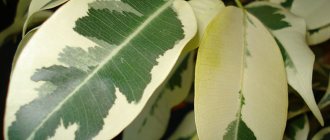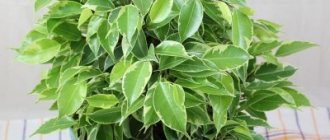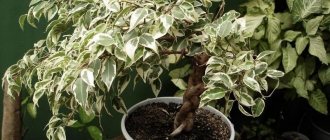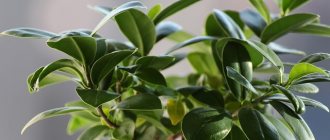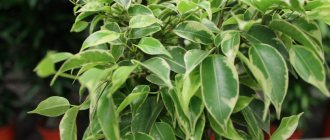Among its relatives, Ficus Benjamin stands out for its medium-sized graceful foliage and spreading crown.
With the advent of new plant varieties, its popularity is growing, and for many gardeners the question becomes urgent: “How to propagate Ficus Benjamin?” All ficus trees are hardy and very tenacious. Their shoots, in contact with the soil, form roots and give life to new plants. Aerial roots, descending to the ground, provide additional nutrition to the growing crown. Even the unusual shape of the fruit seems to be designed so that birds eating the pulp will peck and then disperse the seeds.
But how to propagate ficus benjamina at home? Are there any special features or pitfalls here? Plants of this species reproduce vegetatively without complications. The most common method is cuttings. Most plants are propagated in this way. Among them are hibiscus and lemon.
On the topic: ficus benjamina care at home photo!
Propagation of ficus benjamina by cuttings
To obtain young ficus trees, it is not at all necessary to take only the apical parts of the shoots. The plant develops when a stem cutting with buds dormant in the axils of the leaves takes root.
If there is not enough planting material for propagating Ficus Benjamin, even a single bud will give life to the shoot.
Cuttings are cut from an adult plant so that:
- the base of the future seedling was semi-lignified, that is, still flexible, but no longer green, like newly formed shoots;
- there were from 4 to 6 unfolded leaves on the stem.
On cut stems of all varieties of ficus, milky juice is released. Before rooting, it is removed under running water or using a soft cloth. The lower leaves that interfere with rooting are cut off:
- Immature, green cuttings are almost impossible to root. From prolonged exposure to water or substrate, they rot and die.
- If the gardener has only fragments of adult, lignified branches at his disposal, then there is a chance to get roots.
How to root Ficus Benjamin in the latter case? The base of the cutting is carefully cut along the stem with a very sharp knife. There may be several such cuts. To prevent parts of the cutting from touching, place a match or toothpick between them. This original technique allows you to stimulate root formation on ordinary cuttings, and is also used by bonsai lovers to obtain miniature plants of the most bizarre shapes.
When propagating ficus benjamina, cuttings are rooted in several ways:
- in water;
- in perlite;
- in a light, loose substrate, for example, consisting of peat, crushed charcoal and sand.
At an air temperature of at least 20 °C and high air humidity, roots will form in 2–4 weeks. To speed up the process, use an indoor greenhouse or cover the container with cuttings with a bulk bag.
The roots formed during the propagation of Ficus Benjamin are quite powerful. When they grow a few centimeters. It’s time to transfer the seedling to its permanent place of “residence” in the ground.
For a young ficus, which willingly and quickly grows a root system, take a ready-made aerated, moisture-permeable substrate. Sometimes you make your own soil mixture. Examples include soil based on leaf and turf soil, peat and perlite. In such soil, the ficus will receive proper nutrition and securely gain a foothold.
In the first weeks of acclimatization, the seedlings are covered with a bag, which is removed when the plant produces its first leaves.
At home, propagation of Ficus Benjamin can be done using cuttings with just one leaf and a small section of the stem.
The main thing is that there is a healthy, viable kidney in the sinus. In this case, the shoot along the internodes is cut into separate fragments, which are immediately dried with a napkin and planted in the substrate. The soil should reach the base of the leaf petiole, and the leaf plate itself should be carefully rolled up and secured in the form of a tube. This will prevent the seedling from evaporating too much moisture, precious for the tiny plant.
When is the best time to perform the procedure?
The optimal time for propagation of Ficus Benjamin is spring. Rooting of cuttings or formation of layering is possible in June, but it is too late to plant seeds. At the beginning of the growing season, it is enough to simply cut last year’s branches into pieces of 12-15 cm. When the ficus begins to grow, you will have to remove the green tops - they will most likely die off during rooting. In summer it is better to immediately take the middle part of the shoot. You cannot wait until autumn, when the stems become woody. During the dormant period, life processes slow down, including the ability to form roots.
Air layering must be separated from the mother branch and planted before the onset of cold weather. They must get used to the substrate as early as possible, otherwise in winter the tender roots intertwining sphagnum or peat will simply die.
Ficus propagation at home by seeds is carried out from late February to early May. If the material is obtained in the summer, it must be planted immediately, but no later than July. On the one hand, the favorable time has been missed, on the other hand, only fresh seeds will sprout. By postponing the operation until the next season, lovers of indoor flowers risk not getting any shoots at all.
Rooting methods
When propagating ficus benjamina at home
cuttings are rooted in water or prepared soil. If the air temperature is maintained at 20-22 °C and the required air humidity is maintained, the shoot will take root within a month. Of course, they make sure that the young shoots are not attacked by insect pests, and that the roots do not rot. With proper care and compliance with sanitary standards, rooting using both methods will be successful. To stimulate cell division and root formation, the bottom of the cutting is treated with Kornevin. A few drops of this or an analogue drug can simply be dissolved in liquid.
In water
Ficus benjamina rooting in water
Reproduction of ficus benjamina
by rooting the shoots in water, they are carried out in a container with a removable bottom. The transplant process will be greatly facilitated. For successful formation of the root system, water is poured so that it does not affect the lower leaves of the shoot, otherwise their leaf plate will begin to rot. To prevent trunk rot, dissolve coal powder in water. The conditions for growth are the same as for an adult plant. The fluid is changed periodically. When the ficus cuttings give roots, the seedlings are planted in the ground for a permanent place of “residence”.
In the ground
A longer method in time. Sections of processed and dried twigs are sprinkled with charcoal powder. Then they are lowered onto one bud into prepared and disinfected soil. As soon as the seedling is planted, the soil should be watered with warm water and lightly compacted. For successful rooting, young ficus benjamina
placed in an improvised greenhouse.
It is created from cling film or a bag in which a hole is made. The polyethylene should cover the pot with soil, leaving the shoot outside. As with the previous rooting method, the pot is placed in a warm, bright place, avoiding direct drafts and maintaining moderate soil moisture. Make sure that it is not overfilled. Periodically, the cellophane is removed to ventilate the substrate. This will prevent rotting of the roots. When young growth forms foliage, propagation of ficus benjamina
went well.
Air layering
Adult plants with large leaves and woody shoots reproduce well using this method. It is more labor-intensive than cuttings or leaf ones, but it will help the ficus rejuvenate. It is often used for large-leaved ficus, which has begun to lose its aesthetic appearance, for example, has lost its lower leaves. Another case is large varieties, which, due to their characteristics, have foliage only at the tops.
To begin, select a suitable layering. It should be longer than regular cuttings. Sometimes you can make a whole branch by layering. Having selected a large stem in the place where you would like to see roots, make a deep notch. To prevent the edges from closing and becoming overgrown again, you need to wipe off the sap that appears, and then insert a match or a small stick into the cut. Another option is to cut off a 2–3 cm section of bark from the broadleaf ficus in the appropriate place.
Then wet sphagnum moss should be applied to it - it will provide good nutrition to the young roots and at the same time prevent them from rotting. A section of the stem should be wrapped with polyethylene on top of the moss - not too tightly so that air is still present underneath it. At the bottom, the polyethylene must be securely fastened, for which you can use electrical tape. At the top, the fasteners will need to be removed from time to time to moisten the moss, so it is better to use thread there.
Hobbyists who have rooted broadleaf ficus plants using this method say that young roots appear at the cut site in about 3-4 weeks, but you should wait two to three months until the roots are large enough to completely entwine the moss and become visible. After this, the shoot is finally cut off.
Home care for young ficus grown from air layering is as follows: it should be planted in light soil, preferably peat, and at first maintain fairly high levels of soil and air humidity.
Seed propagation
If there is nowhere to get cuttings for propagating ficus, you can buy the seeds of this evergreen flower in the store. Planting must be done in moist, nutritious, specially prepared soil to a depth of 0.5 cm. To prepare the substrate, take one part of turf soil, one part of perlite, one part of leaf humus and bone meal at the rate of 10 g per 10 liters of the mixture.
When propagating seeds, the plant requires constant care:
- the temperature where the box with seedlings is located should always be within 22-26°C;
- throughout the entire germination period, regularly and moderately moisten the soil (about 3 months).
As soon as the first pair of leaves emerge from the ground, the seeds have sprouted and the ficus can be planted.
The seed propagation method is not very popular among gardeners, since propagation takes a lot of time and there is not always a guarantee that, despite constant care, at least one seed will germinate.
How to propagate ficus benjamina at home
Currently propagating Ficus Benjamin
carried out through the following four methods:
- sowing seeds;
- cloning;
- seedling cuttings;
- selection of layering.
Propagation by seeds at home
hampered by low performance.
Cloning is usually used for industrial purposes. In this case, a new flower is grown from a leaf. Ficus Benjamin
tolerates propagation by cuttings and layering best.
Apical cuttings
Reproduction by apical cuttings photo
Before propagating Ficus Benjamin
cuttings, you should make sure that the main plant is not infected and not too old. Semi-lignified cuttings 9-15 cm long are cut from the top of the bush with a sharpened knife at an angle of 45° closer to the node. Remove excess foliage, leaving 3-4 leaves. The released milky juice must be washed off. By drying out, it prevents the full development of the root system. You can put the sprout in warm water, changing it until the milk stops secreting. After this, the cuttings are dried and placed in a vessel with water at room temperature.
Attention! Do not cut cuttings with scissors or blunt objects. Plant tissue can be crushed, which will slow down the rooting of branches.
To avoid rotting of the cuttings, dissolve an activated carbon tablet in water and make sure that the leaves do not touch its surface. Container with cuttings at home
Place in a bright place, avoiding direct sunlight.
As evaporation occurs, water is added. After half a month, Ficus Benjamin
will form growths at the end of the cuttings, from which roots will form. When their length reaches 3-5 cm, the seedlings can be planted in the substrate.
Stem cuttings
propagation by stem fragments photo
How to propagate Ficus Benjamin
method of isolating cuttings from stems? The woody shoot can be cut into segments. Each of them should have 2-4 sheets. The upper cut is made above the bud in the axil of the leaf, and the lower cut is cut obliquely, taking the part between the nodes. After washing, stopping the secretion of milky juice and drying in air, the cutting is buried in the ground up to the petiole of the leaf, and the leaf itself is rolled into a tube and tied with tape or an elastic band.
Attention! With this type of cutting, roots form more slowly. It is expected that some fragments will not take root at all.
At home
containers with planted cuttings are covered with polyethylene to maintain the desired level of humidity.
Roots and first leaves can form in 1-1.5 months. To speed up rooting, several cuts are made on the lower cut of the branches. This way Benjamin’s ficus
will become more active in growing a new root system.
Air layering
Reproduction by air layering photo
Ficus benjamina propagation
It withstands air layering as well as rhododendron. In the middle of the trunk or woody branch, remove the foliage and carefully cut off the bark in the shape of a ring. The exposed tissue is treated with Kornevin. Then it is covered with damp moss or a substrate based on it and carefully wrapped in film, securing the structure with tape or rope.
The first roots at the cut site will appear in about two months. After this, the cuttings are released, and the new seedling is cut below the newly formed rhizome. The cut areas are easily sprinkled with charcoal powder. The young cuttings can be planted in the ground.
How to do it right
First you need to prepare everything you need. Do not forget about disinfection of the products used.
Required materials and tools
In the process of preparing cuttings you will need:
- mother plant;
- container;
- filler;
- container with water;
- pruning shears or sharp knife;
- alcohol solution or other disinfectant;
- root stimulator.
Step-by-step instruction
It is easier to complete the work of harvesting and rooting cuttings if you follow this sequence.
- First stage. Select lignified or semi-lignified shoots on the mother plant, the length of which reaches 5-15 cm. They should have 2-3 nodes. You can take cuttings from both the top and side branches.
- Second phase. Make an incision with pruning shears under the lower bud. In this case, the pruning shears are installed at an angle of 45°. Cuttings should be treated with a product that activates the development of the root system (for example, Kornevin). This will speed up the rooting process.
- Third stage. To remove the milky juice released at the cut site, you need to place the cuttings in a container with warm water. Soak the workpieces in the liquid for an hour.
- Fourth stage. Fill the container with sand or a mixture of peat and perlite. Other fillers are also suitable: perlite, vermiculite, sphagnum moss. After lightly moistening, plant the cuttings in a container.
- Fifth stage. The container is covered with a glass jar or glass. The workpieces are kept in a warm room at a stable temperature of 25-26°. Periodically, the filler is slightly moistened. After 2-3 weeks, the cutting produces thin root shoots.
Features of ficus propagation by layering
How to propagate ficus benjamina at home by air layering - a more complex method than cuttings, but it is much more interesting. Part of the bark is cut off from a trunk or well-lignified shoot in a ring-shaped manner. This must be done very carefully so as not to damage the middle.
The “wound” is treated with Kornevin (a good stimulator of root growth) and wrapped around with moistened moss. Instead of moss, a sphagnum-based soil composition is often used. Everything is fixed with polyethylene and secured with tape.
Next, observe the process: roots will soon appear on the cut. They should be freed, and the shoot itself should be cut below them and planted in a permanent pot with previously prepared nutrient soil. It is important not to forget about the tree that served as a donor by treating the wound with crushed coal or garden pitch.
Now the new little Ficus Benjamin tree is growing on its own, and if the branch is planted in good soil, it will definitely take root.
You can tell your friends and acquaintances about how to grow a ficus from a twig. This interesting method is most often used by plant growers who grow small bonsai trees - this way they get a large number of aerial roots that hang from the ficus, giving them originality and decorativeness.
Advice from flower growers
The rubber ficus is an unpretentious plant because it does not require special care. However, he is also sick. It is worth considering the most common diseases and their causes.
- The leaves have turned yellow. If you care for your ficus incorrectly, the leaves will begin to turn yellow. The reasons include the wrong size of the growing container, high content of fertilizers, especially salts, and the presence of rot on the roots.
- Leaves fall. Usually old leaves fall off naturally. If a plant “loses” young foliage, then the reasons may be increased soil moisture, rather infrequent watering, lack of lighting, sudden changes in temperature or the presence of drafts.
- The plant doesn't grow. The reason for this may be a cramped pot, a minimum of nutrients, or a lack of light.
The rubber plant is a luxurious plant with large, shiny leaves. It looks great in various interior styles, and also perfectly purifies the air, so it is in high demand among gardeners.
To learn how to propagate ficus at home, see the following video.
We propagate ficus in the ground
There is another way to propagate ficus using cuttings at home - planting cut branches directly into the ground. To do this, you need to select a special mixture of soil that young ficus plants love. If you want to make the mixture yourself, for this we take in equal parts:
- peat soil;
- sand;
- leaf humus.
You can also find packages with the finished substance in stores; they are also suitable for this procedure.
For such rooting, we prepare cuttings in the same way as in the instructions above. After that:
- take the dried cut and sprinkle it with crushed coal;
- we plant the sprout in the ground on one bud;
- cover the plant with a three-liter jar, thus creating a mini greenhouse for it, a plastic bag will also do;
- we water the soil moderately, until it grows it should not be dry, but at the same time you should not make a “swamp”;
- put the pot in a warm place, for example next to a radiator, but no direct sunlight;
- When the branch takes root, you will see new leaves, after which we gradually remove our greenhouse. We start with 15-20 minutes a day so that the tree gets used to the new conditions.
Description of ficus
The roots of some ficus trees are so strong that they can penetrate the cracks of rocky rocks and destroy them. Some of the representatives of the genus Ficus are stranglers of their fellow plants - they begin their life cycle on the branches of other plants, where they fall in the form of seeds with the help of birds and wind.
Various types of indoor ficus
They don't need soil to grow. They germinate in the tissues of a foreign plant and receive vitality from it. Absorbing sunlight and moisture from the air, they gradually form aerial roots, which then entwine the owner of the place and oppress him. As a result, the plant that sheltered the foreign seed dies, and a ficus strangler grows above it, relying on the openwork of the root system.
Ficus aerial roots
Of the 1000 plants included in the genus ficus, dozens of its representatives fit into home interiors. Various indoor ficus plants were popular back in the era of our great-grandmothers. The list of the most famous includes tree species:
- various varieties of large-leaved and small-leaved Benjamin ficus with drooping branches and densely spaced leaves;
- rubber varieties containing milky sap in their stems;
- variegated varieties with different leaf shapes.
Important! Flower growers believe that growing ficus trees is not a difficult matter. Indeed, knowing how ficus reproduces, with the right approach to growing these plants, you can grow them without much effort
Planting cuttings
Planting cuttings of ficus benjamina photo
If ficus benjamina is propagated
transferred in water with rooting, then it is planted in a pot. Planting is carried out in accordance with the following steps:
- choose a pot or flowerpot with holes at the bottom and fill the bottom with a layer of drainage made of expanded clay, small pebbles, fragments of brick or tile;
- fill the pot with a layer of prepared soil, leaving 2-3 cm to the top;
- moisten the ground, make a hole and place the cutting in it, having previously cut the roots to the same length;
- The roots are covered with soil, without compacting them too much, as this can damage the delicate root system of the plant. The soil itself will be brought down to the desired level by watering.
Young ficus benjamina
requires a ventilated, moisture-permeable and nutritious substrate. If it is not possible to buy a ready-made earthen mixture for ficus in the store, then it is created independently from soil, turf, peat, sapropel, sand and perlite collected under leafy trees.
Ficus diseases and pests
With inappropriate care, a radical change in the microclimate of the room, or exposure of the ficus to scorching sunlight, the tree begins to “suffer.” Hinting to us by leaf fall, yellowing of leaves or wilting.
There are not many reasons for this behavior of the ficus. Either the tree does not have enough moisture or needs additional feeding, but what to do when proper care results in the most serious problems, namely diseases?
So, one of the most common diseases of all indoor ficuses are fungal infections, such as:
Gray rot develops quickly, eventually affecting the entire part of the tree. The foliage and trunk become covered with black spots, and leaf fall begins. The reason can be attributed to excessive waterlogging of the ficus, stagnant microclimate and low room temperature - below 23 degrees.
Treating the plant with fungicides, cutting off the affected branches and drying the soil are the main stages in the fight against gray mold.
After treatment, the tree is isolated from other plants to avoid re-infection until all plants have undergone antifungal therapy.
Brown spot or Phyllosticosis of houseplants, another fungal disease that affects the foliage of a plant and spoils the appearance. A species is an evolutionarily developed set of individuals characterized by a single..., the infection can be caused by untreated soil, dirty hands or new plants.
Outwardly it looks like rust covering the surface of the sheet.
The affected plant withers over time, loses its leaves and dies. In a rush to fight the enemy, they use fungicides (phytosporin, rovral, falcon and others), manganese solution, Bordeaux mixture and, of course, pruning the affected branches. After treatment, the tree is quarantined.
Spider mite , a pest that settles on the surface of foliage and weaves a web between twigs; if you notice thin threads in a pot or on a tree, stock up on insecticides and treat the affected plant, isolating the rest.
Scale insects , another pest that does not respond well to insecticides. If brown dotted spots with a sticky surface appear on the foliage, then the plant is affected. The scale insect is washed off with a copper-soap solution, after pruning as much as possible, then the soil and crown are treated with insecticides and the plant is quarantined.
